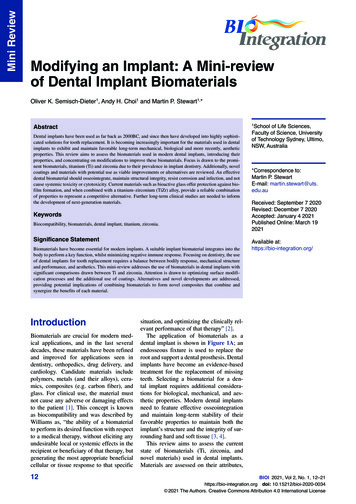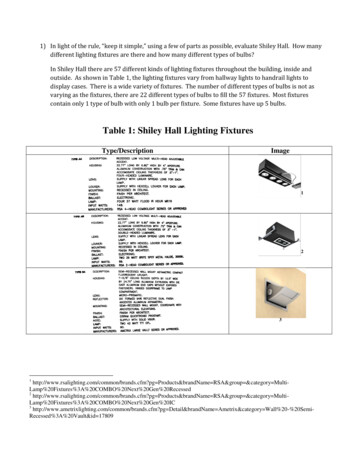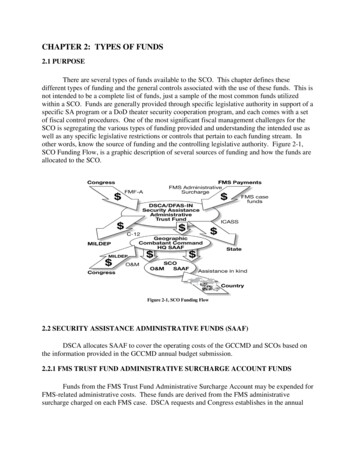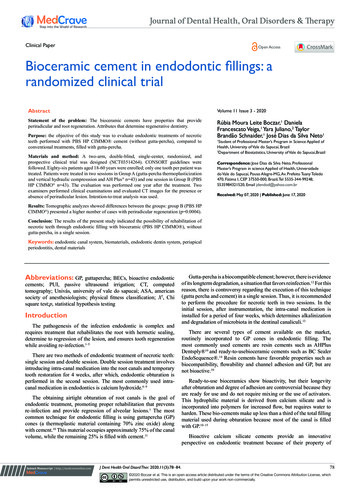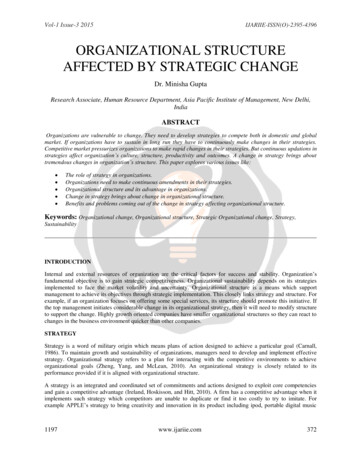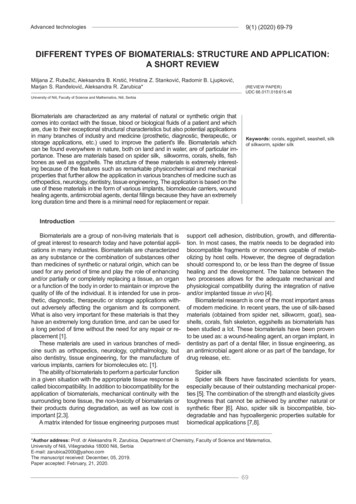
Transcription
Advanced technologies9(1) (2020) 69-79DIFFERENT TYPES OF BIOMATERIALS: STRUCTURE AND APPLICATION:A SHORT REVIEWMiljana Z. Rubežić, Aleksandra B. Krstić, Hristina Z. Stanković, Radomir B. Ljupković,Marjan S. Ranđelović, Aleksandra R. Zarubica*(REVIEW PAPER)UDC 66.017/.018:615.46University of Niš, Faculty of Science and Mathematics, Niš, SerbiaBiomaterials are characterized as any material of natural or synthetic origin thatcomes into contact with the tissue, blood or biological fluids of a patient and whichare, due to their exceptional structural characteristics but also potential applicationsin many branches of industry and medicine (prosthetic, diagnostic, therapeutic, orstorage applications, etc.) used to improve the patient's life. Biomaterials whichcan be found everywhere in nature, both on land and in water, are of particular importance. These are materials based on spider silk, silkworms, corals, shells, fishbones as well as eggshells. The structure of these materials is extremely interesting because of the features such as remarkable physicochemical and mechanicalproperties that further allow the application in various branches of medicine such asorthopedics, neurology, dentistry, tissue engineering. The application is based on theuse of these materials in the form of various implants, biomolecule carriers, woundhealing agents, antimicrobial agents, dental fillings because they have an extremelylong duration time and there is a minimal need for replacement or repair.Keywords: corals, eggshell, seashell, silkof silkworm, spider silkIntroductionBiomaterials are a group of non-living materials that is support cell adhesion, distribution, growth, and differentiaof great interest to research today and have potential appli- tion. In most cases, the matrix needs to be degraded intocations in many industries. Biomaterials are characterized biocompatible fragments or monomers capable of metabas any substance or the combination of substances other olizing by host cells. However, the degree of degradationthan medicines of synthetic or natural origin, which can be should correspond to, or be less than the degree of tissueused for any period of time and play the role of enhancing healing and the development. The balance between theand/or partially or completely replacing a tissue, an organ two processes allows for the adequate mechanical andor a function of the body in order to maintain or improve the physiological compatibility during the integration of nativequality of life of the individual. It is intended for use in pros- and/or implanted tissue in vivo [4].thetic, diagnostic, therapeutic or storage applications withBiomaterial research is one of the most important areasout adversely affecting the organism and its component. of modern medicine. In recent years, the use of silk-basedWhat is also very important for these materials is that they materials (obtained from spider net, silkworm, goat), seahave an extremely long duration time, and can be used for shells, corals, fish skeleton, eggshells as biomaterials hasa long period of time without the need for any repair or re- been studied a lot. These biomaterials have been provenplacement [1].to be used as: a wound-healing agent, an organ implant, inThese materials are used in various branches of medi- dentistry as part of a dental filler, in tissue engineering, ascine such as orthopedics, neurology, ophthalmology, but an antimicrobial agent alone or as part of the bandage, foralso dentistry, tissue engineering, for the manufacture of drug release, etc.various implants, carriers for biomolecules etc. [1].The ability of biomaterials to perform a particular functionSpider silkin a given situation with the appropriate tissue response isSpider silk fibers have fascinated scientists for years,called biocompatibility. In addition to biocompatibility for the especially because of their outstanding mechanical properapplication of biomaterials, mechanical continuity with the ties [5]. The combination of the strength and elasticity givessurrounding bone tissue, the non-toxicity of biomaterials or toughness that cannot be achieved by another natural ortheir products during degradation, as well as low cost is synthetic fiber [6]. Also, spider silk is biocompatible, bioimportant [2,3].degradable and has hypoallergenic properties suitable forA matrix intended for tissue engineering purposes must biomedical applications [7,8].*Author address: Prof. dr Aleksandra R. Zarubica, Department of Chemistry, Faculty of Science and Matematics,University of Niš, Višegradska 18000 Niš, SerbiaE-mail: zarubica2000@yahoo.comThe manuscript received: December, 05, 2019.Paper accepted: February, 21, 2020.69
9(1) (2020) 69-79Advanced technologiesSpider silk represents a whole class of materials withdifferent properties because a spider can produce severaltypes of silk.Fiber synthesizing spiders can produce up to 7 differenttypes of fibers that are composed of 1 or 2 spindroins, allof which are encoded by the members of a single genefamily [9].The most important are three types of fibers: MA (Majorampullate) fibers-Tensile fibers, MI (Minor ampullate) fibers,Flagelliform fibers. They are illustrated in Figure 1.Silk of SilkwormSilk fibroin-based biomaterials are most commonlyproduced from the protein of the domestic silkwormBombyx mori (Shown in Figure 3. (A)), which is the largest producer of silk fibers. At the end of the larval-shapedphase, after the spinning process, the silkworm createscocoon-shaped silk fibers (Shown in Figure 3.(B)). Theamount of fiber in one cocoon is 600-1500 m [4].The cocoon fiber is composed of two protein components, fibroin and sericin (Shown in Figure 3. (B)), originally synthesized in the posterior and middle glands ofthe silkworm. Fibroin is a major component of the cocoon and forms the filament core, while water-solublesericin cements fibroin fibers in the cocoon as glue . Silkfibroin (Shown in Figure 3. (C)) is essentially a fibrousand structural protein, characterized by long-term ordered molecular secondary structures formed by heavy(H) and light chain (L), the chains linked via disulfidebonds at the C terminal end; the amino acid composition of fibroin chains is made of 12 repeat domains inthe form of clustered oligopeptides Gli-Ala-Gli-Ala-GliSer,[Gli-Ala]nGli-Tir and [Gli-Val]n-Gli-Ala(n), separatedwith 11 amorphous regions composed of Gli-AlaGli-Serand Gli-Ala-Gli-Ala-Gli-Ser. The H chain, more abundantFigure 1.The illustration showing a spider and its glands re- than hydrophobic amino acid residues, has a high mosponsible for producing different types of fibers, as well as the lecular weight ( 350 kDa) and is an essentially amphifunctions of these fibers [10].philic exchangeable copolymer block with amorphousregions. The L chain (MV 26 kDa) is more hydrophilicFibers called Major Ampullate (MA), that is, tensile fib- characterized by a higher content of Glu and Asp resiers have the best characteristics, making the outer frame a dues [4].net which also serves as the most important fiber for spiderThe structural hierarchy of hydrophobic and copolymerlife [11]. Two classes of Major Ampullate spidroins which blocks in Bombyx mori silk fibroin demonstrates a unique selfdiffer in the proline content and hydrophobicity [12] have assembly capability that enables substrates with outstandingbeen identified in fibers, termed MaSp1 and MaSp2. All physico-chemical, biological and mechanical properties to beMajor Ampullate spidroins consist of the nucleus [13].made, making silk fibroin a promising and first choice materialThe nucleus contains various parts with amino acid (rich suitable for innovative biotechnological applications [4].in glycine and polyalanine) which provide secondary structures that are responsible for the mechanical properties ofthe fibers [13 - 16]. The end portions of the nucleus play animportant role when storing spidroins [17 - 20].The biotechnological production of spider silk proteins,as well as the development of silk processing techniques,made it possible to use these materials for biomedical purposes such as implant coatings, drug release systems ortissue engineering and much more.Figure 3. A) House silkworm Bombyx mori (Mulberry species); B)Bombyx cocoon composition: fibroin fiber core coated with sericinlayers; Scheme of fibroin structure and amino acid sequence [4].Figure 2. Spider silk in nature [85].70
Advanced technologiesEggshellEggshell is a commonly used biomaterial in nature. Itis a material often used to treat potential waste becauseit is a by-product of the food industry and is consideredas waste after the egg production. A fresh eggshell consists of a typical three-layered form; the foamy cuticle onthe outer surface resembles ceramics; a spongy middlelayer; the inner layer consists of lamellar layers (Shownin Figure 4.). Together with the membrane, the eggshellrepresents 11% of the total egg weight, and its majorcomponent is calcite CaCO3 (94%). The remaining components include MgCO3 (1%), Ca3(PO4)2 (1%), and organic matter (primarily insoluble proteins) (4%) [21]. It ischaracterized by an unique microstructure [22,23] andhas very interesting application potential [24,25]. Despite its abundant application, the material is not beingused adequately in the industry.Specific areas involving its use are as follows: fertilizerand soil improver [26], as a heavy metal sorbent [27,28]or dye [29], as a source of calcium for the synthesis ofhydroxyapatite which is later used in tissue engineering[30] , as a source of calcium oxide for CO2 sorption [31],or as a precursor for composite materials further used invarious fields [32,33]. If the eggshell biomaterial is on thenano-scale, its application potential is expanded [34,35].The industrial waste of the eggshell also contains amembrane of the shell and is suitable for a wide vari-9(1) (2020) 69-79ety of applications [36]. The treatment of the eggshell byvarious techniques can further expand its range of application. One such approach is mechanochemical [37,38].As mentioned above, the major component of theeggshell is calcite with a trigonal crystalline structure. According to the literature, they are prone to phase transformation into orthorhombic aragonite and vice versa.A mechanochemical study of pure calcite has shownthat it converts to orthorhombic aragonite if appropriatemilling conditions are applied [39–41], mainly becauseit is stable at high pressures and has a higher density((ρcalcite 2,71 g cm-1, ρaragonite 2,94 g cm-1). Total conversion from one phase to another was not observed,and the equilibrium ratio between calcite and aragonitewas about 30:70. A similar result was obtained when theprocess started with pure aragonite [39]. However, whenthe milling process was not as intense, no transformation was observed [42]. The eggshell material is different from pure calcite and, as documented in several papers, some authors have noted the transformation, whilesome have not. The presence of an eggshell membranein the system can also affect this transformation.Calcification of the eggshell is considered to be oneof the fastest known processes of biomineralization, andthe largest part of the mineral contained in the eggshellis calcite, a needle-like hydroxyapatite in small quantitieswhich is located in the inner cuticle [43].Figure 4. a) Artistic representation of the cross-section view of an eggshell; b) The structure ofthe egg (upper inset: substructure of the eggshell membrane; lower inset: a photograph of theinner eggshell membrane) [44].SeashellMollusk shells are fascinating organic compoundswith powerful mechanical properties. These shells aremainly made of crystalline polymorphs of calcite andaragonite (Shown in Figure 5.). Fleischli et al. [45] thinkthat, due to their structural alignment and nacres calledas mother of pearl, these natural materials exhibit outstanding properties and this is considered as a standard for the properties of seashells. Barthelat et al. [46]investigated the nacres and found that it is an iridescent material and forms the inner layers of the shells.Chateigner [47] suggested that the nacres have a goodlamellar structure and a better microstructure than anyother marine shell. Barthelat [48] stated that shells ex-hibit better rigidity, strength, and hardness due to theirmicrostructure. Falade et al. [49] examined the suitability of palm kernel shells as fillers for structural and nonstructural purposes. Mollusk shells are natural composites biologically engineered on nanoparticles. Kaplan etal. [50] have suggested that this property can providetoughness and can be a profitable property for the development of biocomposites.71
9(1) (2020) 69-79Advanced technologiesgineering as a replacement for human bones for morethan 10 years, but also in various fields of medicine:orthopedic, craniofacial, dental and neurosurgery. Theadvantage of using bones that have coral in their composition is that the material is extremely stable and easilydecalcified. Natural coral is characterized by a pore sizeof 150-200 µm and a porosity of 36% [63].Various types of corals of the genus Porites, Goniopora, Alveo-pore and Acropora were used in the studies.However, so far there has been no information on thepossible practical use of deep-sea (Gorgonacea: Isi-didae) octocorals growing in the environments conditionedby high pressures ( 80 atmospheres) and very low temFigure 5. Schematic of nacre with the brick-and-mortar like peratures (2-4 C) [63].structure in which hard aragonite-rich plates are glued togetherConcerning the coral structure, it is dominated by thewith the soft organic matrix to form tiles. [51].presence of calcium carbonate in the form of calcite andaragonite, but there are also organic matter and impuriThere is a number of shells, some of which are: a ties that disappear by heating the coral material at temshort-necked shell, a bloodsucker, and a hard shell. The peratures above 900 C. The thermogravimetric curve ofshort-necked shellfish (Paphia undulata) is a marine or- the coral shows a weight loss at 680 C, which occursganism that has a fast-growing rate but a short life span due to the decomposition reaction of calcium carbonate[52,53]. Anadara granosa or known as bloodsucker is present in the coral itself. Synthetic calcium carbonateusually found in the intertidal mud, and it has a shell that decomposes to 898 C. The observed decomposition atis of white color [52,54]. As for the hard shell, which is 680 C may occur due to the substitution of certain ionsalso known as Meretrik lirata, it has a thin hard shell and in the calcite phase, or eutectic reaction caused by thecan be found near coastal areas [55].combustion of the organic matter. However, heating theThe world production of mollusks in 2015. alone is coral material at the temperature of 900 C is necessaryestimated at 16 million tonnes. However,this led to the for the removal of any impurities present, as well as forcreation of copious amounts of the sea shell waste. The the decomposition of the carbonate phase [63].seashell waste is mainly used for low-value recycling,The following types of coral materials have previouslysuch as in the craft industry for the production of decora- been used for biomedical purposes: coral hydroxylapative materials like key chains and as a recycling medium tite and aragonite, coral granules, natural coral fragfor the road construction, as well as brick for construc- ments, newly developed coral-composite materials andtion [56,57].coral powder (coral calcium) [63].Thus, seashells are underutilized and they are stillconsidered waste. Due to a costly disposal process suchFishbonesas incineration [58], the seashell waste is generally disFishbones are a material that is economical and easyposed of in landfills without any subsequent treatment.to obtain. It also contains porous structures of calciumLandfills often cause an unpleasant view of the en- carbonate CaCO and calcium phosphate Ca (PO )334 2vironment and give off an unpleasant odor. To reduce which have ions thatare naturally present in the bone.the negative environmental impacts, researchers areDue to its similarity to the bone structure, and due tostudying the transformation of the seashell waste into its composition, crystallinity, pore size and biocompatvaluable products such as biomaterials. Biomateri- ibility, being a natural material fish bones can be used asals are synthetic or natural materials that are suitable an alternative material primarily with bone damage [64].for the manufacture of artificial organs and dentures orThese materials are obtained from the fish present inbone or tissue replacement. In fact, seashells consist of various aquatic systems but also from those not used incalcium carbonate (CaCO3) of over 95% by weight [59]. the food industry. Globally, more than 50% of fish catchIt has previously been used as a source of calcium for es are not produced as a valuable food product, butthe synthesis of hydroxyapatite (HAp) [60,61]. With the thrown away in huge quantities reaching more than onechemical formula Ca10(PO4)6(OH)2, HAp is widely used million tonnes of unwanted bio-waste. Huge quantitiesin biomedical applications, mainly as a substitute for of fish by-products are wasted and create an adversebone, regeneration and dental renewable materials due environmental impact.to their biocompatibility, biosorption, and bioactivity. HAPFishbones have recently been used as an inexpenis reminiscent of natural bone and has the ability to allow sive source for the preparation of natural hydroxyapatiteschemical bonding with the bone structure [62].(HAp). However, the properties of the synthesized fishCoralsNatural coral has been primarily used in tissue en72waste HAp and conventional commercial stoichiometric HAp are different. HAp prepared from the fish wasteshowed a greater biological activity due to the existence
Advanced technologies9(1) (2020) 69-79of essential anions such as Cl- and F-, and cations such material and the improvement of its physical properties,as Mg2 , Al3 , Sr2 , Zn2 , K i Na , and the appearance of the ideal material for all dental applications has not beenboth ions showed a better biomedical application mainly found yet. Composite alternative materials are promisfor the rapid bone restoration. The availability of Na and ing in aesthetic terms but do not satisfy the mechanicalMg2 ions is necessary for the growth and stability of standards of amalgams, and are sensitive to individualbones and teeth, while their absence or small amount dentist techniques.can make bones very fragile and brittle [65].According to the research, the synthesis of HAp fromUsage of biomaterials as an implant (scaffold) forfish bones is a simple and economical method. Kongbone formation/healingsri et al. [67] performed the HAp synthesis from TilapiaBone, consisting mainly of collagen protein and hynilotica fish bone waste and applied for the selenium droxyapatite, provides support and the strength for moveadsorption from aqueous solutions. Similarly, Huang et ment. Critical bone defects or serious bone injuries thatal. [66] have discussed the preparation of HAp from the cannot be regenerated naturally require implant-basedOreochromis fish species (tilapia) using an enzymatic hy- interventions. Implants provide mechanical strength todrolysis method and examined biocompatibility. Abdullah the bone, but also accelerate the growth of natural tiset al. [68] prepared HAp from Black tilapia by a calcina- sue [72].tion method and confirmed the presence of Na and Mg2 .The use of silk/clay films as composites in tissue orMuhammad et al. [69] synthesized HAp from Cyprinidae bone engineering has been extensively studied. Silk filmfish bones with the help of the ionic liquid treatment and (most commonly obtained from the domestic silkwormexamined its biocompatibility. However, the main disad- Bombyx mori or spider of the Nephila clavipes species)vantage of all the above methods is that it is difficult to serves to support the biomaterial, while the clay/MMTcontrol the crystal structure and size of HAp. Therefore, particles (Montmorillonite) were the source of osteoinit is important to develop a simple, efficient green meth- ductive silicon species.od for obtaining biocompatible nanostructured HAp forThe silk/clay system has been studied with humanvarious biomedical applications [65].mesenchymal stem cells (hMSC) in osteogenic cultureto determine the effect on bone outcomes, against silkUse of biomaterialsand silk–sodium silicate (SS) controls. Clay particlesUse of biomaterials in dentistryprovide an osteogenic stimulus for hMSCs and enhanceSilk has been used in biomedical applications for the bone-related ECM (extracellular matrix) producmany years. However, there are only a few applications tion. Clay was chosen as an adjunct to the silk matrixin dentistry as a material for stitches and the regenera- because natural clay minerals represent an osteogeniction of the dental tissue. Silk is used for the tissue regen- culture. The silk/clay composite biomaterial gave gooderation alone, or in the combination with other materials results. Biomaterials supported the binding, proliferationas composite materials, and new nanomaterials are de- and osteogenic differentiation of hMSCs, maintainingveloped from silk proteins and silica, which combine the high cell viability [73].useful properties of the two components.A silk/silicate film combination can be used for theA material such as hydroxyapatite is an essential same purposes. Spider silk obtained from N. Clavipiescomponent of tooth enamel and dentin because it con- is used as a source of silk. Spider silk served as the ortributes to the strength and hardness of these tissues. ganic phase controlling the stability of the material. Silk/The nucleation of hydroxyapatite and its crystal struc- silicate biomaterial is suitable for various applicationsture is controlled by organic macromolecules such as but especially for the formation of previously damagedosteonectin, phosphoproteins, and dentin matrix protein bones [74].1 (DMP-1). DMP-1 plays a major role in controlling theMesenchymal stem cells derived from human bonenucleation, growth, and morphology of hydroxyapatite marrow and subjected to osteogenic differentiation werecrystals in dentin. Combining spider fibers and DMP-1, used to evaluate the influence of the silk/silica composa biomimetic approach was used to produce biominer- ite system on osteogenesis. Silicon in these silk filmsals. For this purpose, spider fiber protein domains and affected the expression of osteogenic genes, with thethe DMP-1 domain were cloned and the two domains regulation of several osteogenic markers (alkaline phoswere then used for the orientation and nucleation of phatase, bone sialoprotein, and collagen type I). Calcihydroxyapatites. This combination resulting from the um-containing deposits have been observed on silicatebiomineralization process has great potential in tissue films treated with silicates, which is a clear indication thatengineering [70].bone formation has occurred [74].Seashells are used as a source of exclusion for theThe spider silk/calcite composite has led to the develproduction of natural hydroxyapatite. A composite of hy- opment of new applications in the field of bone implantsdroxyapatite (obtained from a shell) with iron was used as and artificial dentures. Characteristics of a good bonea material for titanium coating by the laser pulse deposi- implant are biocompatibility, bone-bonding and strength,tion technique for the application of dental implants. [71].while artificial dentures must have characteristics suchDespite a better understanding of the chemistry of the as the strength necessary for holding (enduring body73
9(1) (2020) 69-79Advanced technologiesweight) and the flexibility in movement (allowing easier and angiogenesis by stimulating osteoblast proliferation,movement). Calcium carbonate on spider silk mattress adhesion, and differentiation; therefore, these composwill provide bone support and improve the alternative of- ites are essential for bone tissue applications. The silkfered to a patient who has had an amputation or has fiber protein extracted from B.mori alone or in combinationbone defects that need to be alleviated [75].with CaP (calcium phosphates) is used to engineer a boneIn the orthopedic field, hydroxyapatite (HAp) na- tissue. Nano HAp/SF powders (Shown in Figure 6.) werenocrystals are sintered and have improved disinfection synthesized using the coprecipitation method and added tobecause of the high surface area. The high surface area the SF (Silk fibroin) solution to produce the nHAp/SF comcan also increase the fracture toughness and mechanical posite material. These composites showed improved presstrength of HAp nanocrystals. Compared to other con- sure properties. Good compression properties were due tostructs, nano HAp showed better bioactivity compared uniform dispersion of nHAp/SF in SF solution, a high surfaceto coarse crystals that extend their applications in tis- area of the needle nHAp/SF powder and a good molecusue engineered implants. Nano HAp has high bioresorp- lar interaction between SF molecules in the structure of thetion properties and similar crystallographic and chemical nHAp/SF powder and SF matrix. Good interface interactionscharacteristics as natural apatite found in the bone. Nano between nHAp/SF powder and SF matrix promoted cell proHAp-containing composites induced both osteogenesis liferation, binding, and differentiation [76].Figure 6. Silk/hydroxyapatite (SF-HAp) composites used in bone tissue engineering [76].Strontium (Sr) is a natural element that can be partSivakumar et al. [78] have shown the possibility ofof the bones because of the similarity in physical and converting the coral found on the Indian coast into achemical structure with Ca contained in them.The incor- product that is extremely rich in hydroxyapatite. However,poration of Sr into the bones shows a better result in the apatite obtained under the experimental conditions usedtreatment of osteoporosis. The addition of Sr to the HAp in this study is in powder form. Powdered hydroxyapatitecrystal leads to a greater distance of Sr-OH than Ca-OH can be used to form bone filling composites as well asdue to the larger ion diameter of Sr, which further leads for osteogenic purposes. It can also be used for plasmato a change in the lattice parameters of apatite. The lat- sprays to coat bioimplants.tice parameters of Sr-substituted HAp increase with inPorous hydroxyapatite implants can be biogeniccreasing the Sr concentration. The addition of Sr2 may powder of hydroxyapatite obtained from the fishboneincrease the solubility of the synthesized HAp, leading (Thickness Perch) and the polymer sponge obtainedto better alkaline activity of osteoblasts and the colla- by the heat treatment at 1250 C for 3 h. Calcined fishgen formation in the physiochemical system. An in vitro bone maintains the microstructural characteristics of rawstudy showed that Sr-substituted HAp powder promotes fishbones. Despite the high porosity of the prepared imosteoblast differentiation and decreases the osteoclast plants, they have mechanical properties sufficient for thenumber and activity. Sr-substituted HAp was synthe- application to the bone material. XRD examination of asized from Mercenaria hard shells by the hydrothermal calcium phosphate layer deposited on the implant surprocess. The effect of Sr substitution on the mechanical face after the immersion into SBF (simulated body fluid)behavior and in vitro cytotoxicity using a mouse osteo- revealed a pure hydroxyapatite phase identical to theblast cell line (MC3T3) was performed to evaluate the standard one [79].potential of biomedical application materials [77].74
Advanced technologiesUse of biomaterials as antimicrobial agentsLoss of the skin tissue when exposed to fire leavesa wound/burn susceptible to dehydration and infection.In serious injuries, burns can take up about 70% of thepatient's skin, which is why deaths most often resultfrom secondary infections. To protect the patient's bodyfrom invading microorganisms at the wound site, wounddressings are used to cover the wound as the skin regenerates [80].Wound dressings are usually made of naturally-derived and biocompatible materials such as silk, specifically. It is very often silk obtained from silkworm (Bombyxmori), although spider silk is also used. These biomaterials often incorporate nanoparticles that have antimicrobial properties to destroy micro-organisms as effectivelyas possible, and prevent them from developing. A particle having such properties is silver in the form of Ag andAg0. Silver is obtained from compounds such as silvernitrate, silver sulfate, silver sulfadiazine [80].Based on many studies and dealing with the fabrication and the evaluation of silk, wound dressings with theincorporation of silver nanoparticles in low concentrations have shown that this combination is particularly effective against the following microorganisms: S. Aureus,P. Aeruginosa and E. Coli (Shown in Figure 7.)[ 80].Figure 7. This image shows the transformation of silk fibroin from(A) unprocessed B. mori silkworm cocoon to (B) extracted, lyophilized silk fibroin and (C) final, electrospun silk fibroin mat [80].9(1) (2020) 69-79Figure 8. The antimicrobial activity of the CeO2/silk composite obtained from Bombyx mori [81].The combination of silk (also obtained from the silkworm Bombyx mori) and zinc oxide (ZnO) can be usedfor the same purposes. ZnO nanoparticles are considered to be non-toxic and biocompatible and are thereforefrequently used. ZnO in the combination with silk fibershas remarkable properties, but particularly pronouncedantimicrobials that are used to suppress bacteria of thespecies Staphylo
shells, corals, fish skeleton, eggshells as biomaterials has been studied a lot. These biomaterials have been proven to be used as: a wound-healing agent, an organ implant, in dentistry as part of a dental filler, in tissue engineering, as an antimicrobial agent alone or a

